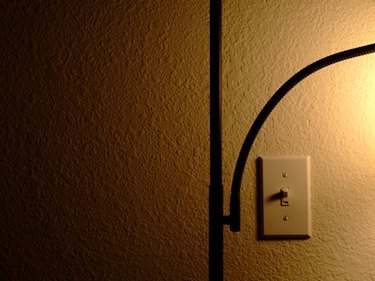Things You'll Need
Craft or pen knife
Straight edge
2-part epoxy
Toothpicks

If you are wallpapering a room and want the light switch plate to blend in seamlessly, cover it with wallpaper to continue your pattern and look. Wallpaper-covered light switch plates can also work in rooms without wallpaper, adding just a touch of style or helping the house decor blend papered and nonpapered room styles together, giving a sense of continuity between rooms. Start with the light switch plate unscrewed from the wall so you can work with it easily, and use a two-part epoxy that is meant for plastic, as standard wallpaper glue will not stick to the switch plate.
Step 1
Lay your wallpaper out on a cutting surface, printed side up, and set your light switch plate on top of it. If you will be trying to match the wallpaper pattern to a certain part of the pattern on the wall, align your plate exactly on the part of the wallpaper you want to use.
Video of the Day
Step 2
Cut out a rectangle of wallpaper around your plate by dragging a small knife along a straight edge or metal ruler approximately 3/8 inch away from the switch plate's edge.
Step 3
Squeeze equal portions of each part of your two-part epoxy out of its container onto a disposable surface, such as the epoxy's packaging. Stir the two parts together with a toothpick and immediately spread the epoxy onto the light switch plate with the toothpick, working from the light switch opening outward and covering the entire surface except the area directly around the screw holes, where the plastic angles inward. Coat the curves where the plate bends toward the wall with epoxy.
Step 4
Set your wallpaper rectangle carefully over the plate's face, centered as you had it when you cut it out. Press the paper onto the plate firmly and smooth out any wrinkles, working from the center outward. Wait for the epoxy to dry completely.
Step 5
Wrap the excess wallpaper around the back and crease it along the plate's edge. You may need to cut slits in the corners to make it fold smoothly.
Step 6
Cut an X with your knife over the light switch opening and fold the resulting flaps back behind the switch plate.
Step 7
Mix another small batch of epoxy the same way you did before, turn the switch plate over, and apply just enough epoxy to tack down the pieces of wallpaper you folded over, both on the edges and around the switch opening.
Step 8
Cut a small X over each screw hole and gently bend back the flaps to insert the screws and attach the plate back onto the wall with a screwdriver.
Step 9
Dab a tiny amount of epoxy onto the screw heads once the plate is in place, and let the flaps fold back over the screws to hide them.
Tip
Some plastics simply won't accept any glue types. If the epoxy does not stick to your switch plate, look for one made of ABS or PVC. If you can't find one, try a metal or wood light switch plate.
Video of the Day